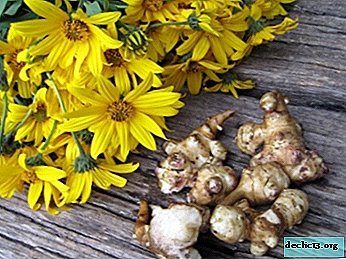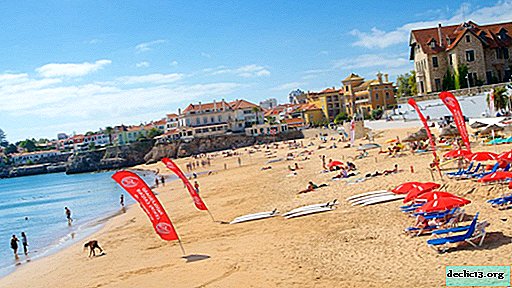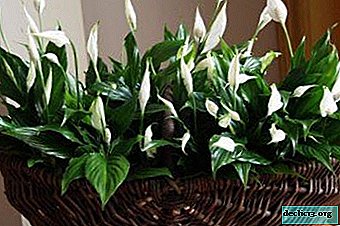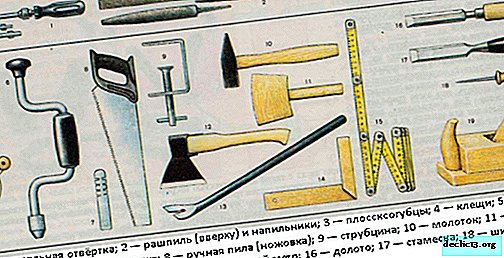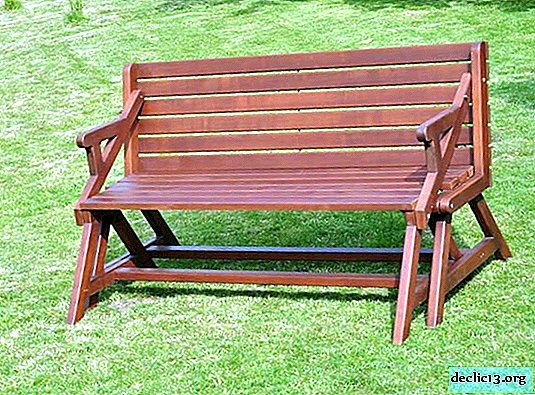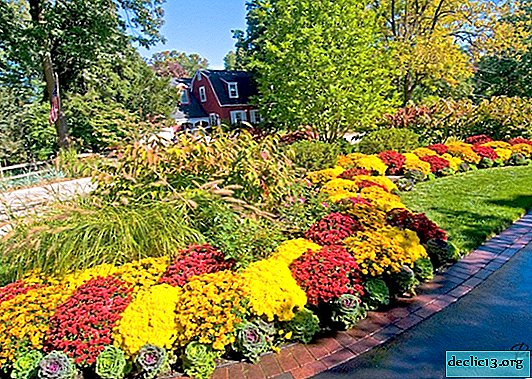Queen of the Garden - the one and only rose "Charles de Gaulle"
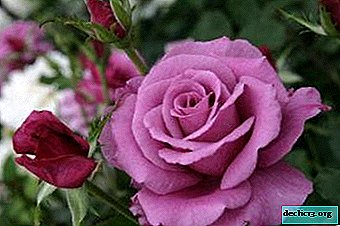
Rosa, from ancient times, is considered the queen of the garden. Rose has long appeared in almost every garden.
The variety of species and varieties of roses is striking in its quantity, so for any gardener there is exactly the sort that suits him best.
In this article you will learn how to distinguish the Charles de Gaulle rose from other varieties, how to properly care for and propagate it. And also what diseases and pests can affect this flower.
Detailed description
Rose "Charles de Gaulle" refers to a group of tea-hybrid roses. The bushes are erect, medium-sized, with a plant height of 80 to 100 cm and a bush width of about 60 cm. The foliage is lush, light green, glossy. Flowers are lilac-blue in color, with a diameter of 10 to 14 cm. The number of flowers on the stem is from 1 to 3. The flowers are cup-shaped, double, consisting of 30-40 petals.
The merits of the variety include:
- plentiful flowering;
- the scent of flowers;
- resistance to diseases and pests;
- relative winter hardiness.
Photo
Below you will see a photo of a rose:





History of occurrence
The variety was named after a famous French statesman and was bred by French breeders back in 1975. During its existence variety "Charles de Gaulle" has been awarded many world awards and titles, including "The Best Fragrant Rose".
What is the difference from the rest of the species?
Since the Charles de Gaulle variety of roses belongs to the group of roses obtained from crossbreeding and tea, he inherited unique qualities from them. Plants of this variety have increased frost resistance, resistance to many diseases and pests. Continuous flowering is also a hallmark of these roses.
Bloom
When and how?
Flowering is long, throughout the summer, from June to September. The aroma of flowers is saturated, persistent, with notes of lemon and verbena. Belongs to re-flowering varieties.
Care before and after
In the first year should not allow the flowering of young plants. Until the beginning of August, it is necessary to remove the buds from rose bushes. In August, 1-2 flowers are left on the shoot until fruit sets. This is necessary so that the shoots of roses matured better and wintered well.
For more abundant flowering, top dressing with complex mineral fertilizers and microelements, as well as watering, at least once a week, are necessary.What to do if it does not bloom?
 The reasons for the lack of buds on a rose bush may be:
The reasons for the lack of buds on a rose bush may be:
- insufficient humidity of air and soil;
- lack or excess of mineral nutrition;
- excessive soil compaction.
Excessive application of nitrogen fertilizers leads to an active growth of the vegetative mass without the formation of buds. In this case, it is necessary to apply phosphorus-potassium fertilizers to restore soil balance.
On very heavy clay soils, due to poor aeration, the rose may also stop flowering. To obtain a lighter grain size distribution, you can add river sand under the bush and gently loosen it.
Use in landscape design
In landscape design, it is often used in rose gardens. Looks great in single landings on a green lawn. Thanks to the dense crown and abundant flowering, this variety looks advantageous against the background of almost any plant and can be used in various compositions and mixborders. Since the rose has a unique aroma, it can be planted near rest places and benches.
Step-by-step care instructions
Seat selection
The plot for planting a rose of this species should be sunny in the morning and evening hours, since under the rays of the bright daylight the petals can fade, changing color to silver-pink. The edges of the petals dry and curl. Strong winds and drafts should not blow through the area.
What should be the soil?
The soil should be well aerated, with good water permeability, eliminating stagnation of moisture. The optimal soil reaction is slightly acidic, pH = 5.6-6.5. The depth of groundwater is not less than 100 cm, otherwise the rose often gets black spotting.
The preferred soils for roses are light loam with a sufficient content of humus. Marshy, saline, and rocky soils should be avoided.Seed planting
Planting roses with seeds can be done in two ways: seedlings and directly into the ground.
Through seedlings
 Before sowing, rose seeds must be stratified at a temperature of 1 to 5 ° C.
Before sowing, rose seeds must be stratified at a temperature of 1 to 5 ° C.
- To do this, the seeds are placed in a sealed bag with wet sand or vermiculite and left in the refrigerator. The substrate should be three times more than seeds. Seedlings appear after 2 months.
- Then the seeds are sown in seedling boxes and make sure that the soil in the box does not dry out. After a month, full shoots appear.
During this period, it is important to monitor the illumination of plants, which should not be less than 10 hours. The optimum temperature for the sprouts is 18 ° C. In April-May, when the plants get stronger, they are planted in open ground.
In open ground
Sowing is done in the fall, so that the seeds pass the natural stratification in winter.
- A trench is excavated on the bed, where seeds are sown, which are only slightly sprinkled with earth.
- The trench is covered with material that retains moisture. In areas with snowless and frosty winters, it is worth sheltering trenches with foliage.
- In the spring, at the onset of stable positive temperatures, the shelter is removed and awaiting the emergence of seedlings.
Care for seedlings is watering, loosening, fertilizing and weeding weeds.
Temperature
The optimum temperature for the growth and development of roses is a temperature of 18-25 ° C. The maximum plus temperature for roses is 35 ° C. Long maximum temperatures lead to a decrease in turgor and inhibition of plants. At 0 ° C, the buds of roses start growing and begin their development.
Short-term temperature drops to -10 ° C roses can withstand, but stable temperatures to -7 ° C lead to the need for shelter of plants.
Watering
Watering is not frequent, but plentiful, 1-2 times a week, with a water consumption of about 5-10 liters. Water for irrigation should not be too cold. The maximum water consumption of the plant falls on the phase of budding and flowering. Accordingly, a lack of moisture during this period leads to a delay in the growth and development of shoots and affects the quality of flowering.
Watering must be carried out under the root system, without falling on leaves and buds, so as not to provoke the development of fungal diseases.Top dressing
 Fertilizing with organic and mineral fertilizers positively affects the growth and development of not only shoots, but also increases the duration and quality of flowering.
Fertilizing with organic and mineral fertilizers positively affects the growth and development of not only shoots, but also increases the duration and quality of flowering.
- In the summer, fertilizing with phosphorus-potassium fertilizers or complex mineral fertilizers is carried out.
- In autumn, to prepare the plant for cold weather, you can make potash fertilizers, such as potassium sulfate, at the rate of one tablespoon per bucket of water.
- In the spring, fertilizing is carried out with nitrogen fertilizers.
Pruning
In the first year, when pruning, it is recommended to leave no more than five buds on strong shoots, and no more than two on weak shoots.
- Spring pruning involves the removal of shoots that are frozen in winter, dried up and affected by disease.
- Throughout the growing season of roses, pruning is performed to remove faded inflorescences along with the top of the shoot.
- In autumn, diseased and damaged shoots are cut, thinly thickened bushes are thinned out.
Transfer
A transplant is best done in the spring, in April - Maywith a lump of earth.
- A landing pit with a depth of about 60 cm is prepared in advance. At the bottom of the pit, drainage of rubble or gravel, about 10 cm, is laid.
- The earth is poured from above, adding humus, coarse-grained sand and complex mineral fertilizer to it.
- A rose is planted in a prepared hole, deepening the vaccination site by 2-3 centimeters.
- When transplanting, the soil is well shed with water, preferably with the addition of the drug Fitosporin.
- The soil around the seedling is mulched with peat.
Preparation for winter
 Winter hardiness of this variety of roses is high. Frosts up to -7 ° C are tolerated by roses quite well and help them get ready for winter.
Winter hardiness of this variety of roses is high. Frosts up to -7 ° C are tolerated by roses quite well and help them get ready for winter.
- Before sheltering, roses are trimmed, ground the base of the bush with earth and after that they cover with fir spruce branches.
- Next, a frame is installed that rises by 20 cm above the plants, is covered with insulation material and a plastic film is pulled, leaving side ventilation.
It is especially important to remove the upper film in the spring in time in order to prevent the plants from aging, especially during the thaw.
How to propagate?
Roses propagate only vegetatively, since only vegetative propagation preserves their varietal qualities.
Cuttings
Cuttings harvested after the first wave of flowering from young and healthy bushes.
- Cuttings cut 5-8 cm long, with 2-3 leaves.
- The lower section is done obliquely, under the kidney itself, and the upper one 1 cm above the kidney.
- To reduce evaporation, a portion of the top sheet and the bottom sheet are removed.
- Before planting, the cuttings are immersed in a solution of the root stimulator of 1.5 cm for 18-20 hours. As stimulants, you can use the preparations "Kornevin", "Heteroauxin", "Sodium humate."
- Then, the cuttings are rinsed and planted on a bed or in boxes.
- On top of the sod-humus soil, a substrate is poured with a layer of about 4 centimeters. Coarse-grained river sand is most often used as a substrate for cuttings.
- Cuttings are planted obliquely, to a depth of 2 cm, after which they are abundantly watered and make shelter of glass or film, like a greenhouse.
Further care is to moisten the plantings several times a day and maintain humidity at 80-90%. After about a month, roots appear on the cuttings, after which the shelter is removed, and the cuttings are grown.
Bush division
 This method of propagation can be used only for root roses.
This method of propagation can be used only for root roses.
- In April (before buds open), the bushes are dug up and divided into parts. Each part must have roots and shoots.
- Shoots after division shorten and leave from 3 to 5 buds.
- The wounds are covered with garden var, and the roots of the plants are dipped in a clay mash, after which the plants are planted in a permanent place.
Layering
- For this, a mature, flexible shoot is chosen, on which an annular cut of the bark is made, about 7 cm long, on the side that will be in the ground.
- A small trench is made near the bush, on the bottom of which a part of the shoot is laid with an incision, fixed with special pegs and covered with a mixture of earth and humus.
Vaccinations
You can plant a rose with a cuttings or buds. For vaccination you need a stock, which is used as a rose rugosa or horsemeat rose. Crowning is carried out from July to August.
- For grafting, only mature shoots are selected. With a grafting knife, cut an eye with a shield about 2 cm long from the graft.
- Next, push the bark into the stock, inserting the shield.
- The vaccine is wrapped tightly with plastic wrap, and the kidney is left free.
A month later, if the kidney remained green, budding was successful.
Diseases and Pests
Variety Charles de Gaulle has medium resistance to disease, is resistant to powdery mildew and weakly resistant to black spotting. Despite the resistance of the variety to diseases and pests, preventive treatments with fungicides and insecticides are recommended.
 The main pests of roses include:
The main pests of roses include:
- aphids;
- spider mites;
- leaflets;
- cut sawflies;
- caterpillars.
Preventive treatment and treatment when the roses are populated by a pest can be carried out with the Fitoverm biological product with a consumption rate of 4 ml / l of water.
Common rose diseases are:
- spotting;
- gray rot;
- powdery mildew;
- infectious burn.
For preventive treatment, when opening roses after winter, you can use the drug "Fitosporin", with a consumption rate of 7 ml / l of water, and in May repeat the treatment, but with a lower consumption rate - 3.5 ml / l. If the infection did occur, the affected leaves are collected and burned, continuing treatment with the drug. You can treat the plants with 5% Bordeaux liquid or 1% solution of copper sulfate.
Rosa "Charles de Gaulle" is very popular not only in landscape design, but also in garden decoration and floristry. The variety is great for cutting. Knowing the basic rules of planting and caring for roses "Charles de Gaulle" will allow you to enjoy the magnificence and delightful aroma of these flowers for a long time.


